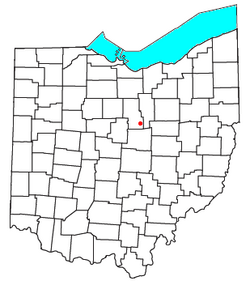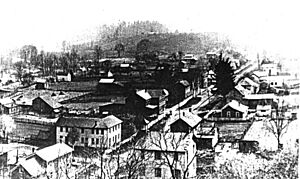Newville, Ohio facts for kids
Quick facts for kids
Newville, Ohio
|
|
|---|---|

Location of Newville, Ohio
|
|
| Country | United States |
| State | Ohio |
| County | Richland |
| Township | Worthington |
| Time zone | UTC-5 (Eastern (EST)) |
| • Summer (DST) | UTC-4 (EDT) |
Newville was a small town in Ohio, United States. It was located near what is now Pleasant Hill Lake. You can find its old spot in northeastern Worthington Township, which is part of Richland County. Today, Newville is known as a ghost town.
Contents
History of Newville
Newville was started by John Frederick Herring. He planned out the town in December 1823. It was built in a small valley where Slater's Run meets the Clearfork of the Mohican River. This area was surrounded by hills covered in trees. Abraham Nye was one of the first people to settle there. He helped convince Mr. Herring to create the town.
Early Mills and Travel
In 1811 and 1812, John Frederick Herring built an important grist mill in Richland County. A grist mill grinds grain into flour. This mill was on the Clearfork river, west of Bellville. To get the parts for the mill, Mr. Herring traveled to Baltimore with a team of six horses. This trip took about two months to complete! Today, you can travel that same distance in just a few hours.
Mr. Herring later sold this first mill. He then built a second grist mill further down the Clearfork river. A few years after that, he planned out the town of Newville around his new mill.
First Settlers and Town Name
The first people to settle in Newville included John Frederick Herring, Abraham Nye, and Michael Hogan. Abraham Nye was the first person to open a tavern. Daniel Stoner was the first blacksmith, and Michael Hogan was the first merchant. Newville was named after Newville, Pennsylvania. This was the hometown of the town's founder, John Frederick Herring.
Why Newville Didn't Grow
When Newville was first planned, the Clearfork river had more water. Pioneers often built towns near rivers for mill power and other uses. People thought Newville would become a very important town. It even hoped to become a county seat, which is the main town of a county. However, these hopes did not come true.
Later, two railroads were built through the southern part of Richland County. But they both missed Newville. The B&O went through Butler, and the Pennsylvania went through Perrysville. Newville was left in the middle, about four miles from each railroad. In the age of railroads, towns that weren't on a train line often didn't grow. Newville was one of these towns.
Early Roads
Most early settlers came to Newville by following the old Wyandot trail. This trail went along the Mohican river and its Clearfork branch. Later settlers used the Portage road. This was a military road built by General Harrison's army in 1812. It crossed Worthington Township diagonally. This road was likely the first one in the township. Even though it has changed a bit, it is still a public road today.
Community Life
Newville had a lively period of religious gatherings between 1825 and 1835. Many different preachers shared their ideas. They often based their beliefs on Anabaptist lines. Some of the most well-known preachers were Sydney and Thomas Rigdon. Sydney Rigdon was known as a very charming and powerful speaker. He later became a Mormon elder.
Worthington Township, where Newville was located, was famous for its "camp-meetings." These were large outdoor religious gatherings. One of the most popular camp-meeting spots was called "Easterly's," west of Newville. These meetings were often led by the United Brethren and Evangelical groups.
At these camp-meetings, people combined social fun with religious passion. People were very enthusiastic in their faith. It was common for people to sing, pray, and shout together. Some people felt so happy they would shout. Others would pray for their friends and family. These meetings were a big part of community life.
Notable People from Newville
Many interesting people lived in or came from Newville.
- Samuel J. Kirkwood: He was one of the first school teachers in Newville. He later became a lawyer and moved to Iowa. There, he became the governor of Iowa. He was also a senator in the U.S. Congress. He even served in President Garfield's cabinet.
- Major Hogan: He was a very smart and polite man. He loved books more than his business.
- Dr. J. P. Henderson: He spent most of his life in Newville. He was a dedicated student and loved studying old artifacts and history.
- Joseph Musgrave: He was a merchant in Newville. He later became a state senator for the Ashland district.
- Major George F. Carpenter: He was a lawyer and banker. His father, Daniel Carpenter, helped start many businesses in Newville. Major Carpenter was also a founding member of the Richland County Historical Society.
- Governor John Peter Altgeld: He spent several years as a boy in Newville. As an adult, he became a famous judge, a great speaker, and a strong leader.
Newville's Businesses
Daniel Carpenter, the father of W. B. Carpenter, was a key person in Newville's business growth. He owned a store that sold many different goods. He also started and ran a tannery, which processes animal hides into leather. He also had an ashery, which made "pearl ash."
In those days, Baltimore was the main market for this part of Ohio. The trip there and back was about a thousand miles. It had to be done by wagons, and part of the journey was over mountain roads. Grain was too heavy and cheap to haul that far. So, things like ginseng, maple sugar, and beeswax were the main products people could sell.
Daniel Carpenter's ashery made pearl ash, which could be exported. His teams traveled for miles around, buying ashes from farmers. This helped farmers earn a little extra money.
Pennyroyal Distilleries
One unique early industry in the area was pennyroyal distilleries. Pennyroyal is a plant that grew in large amounts in southern Ohio. It's an aromatic plant with a strong taste.
Here's how they made pennyroyal oil:
- First, the pennyroyal plant was gathered.
- It was left to wilt, so it would pack well.
- Then, it was carefully pressed into a steam chest.
- Steam would release the oil from the leaves.
- The oil and steam went into a condenser, where cold water cooled them.
- The condensed liquid was poured into a vat of water.
- Since the oil was lighter than water, it floated and was collected.
Pennyroyal oil was used for medicine. Pioneers thought it was good for stomach problems. The last pennyroyal distillery in this area was Fisher's at Palmyra. They also made peppermint oil there.
Abandonment of Newville
In the 1940s, the U.S. Army Corps of Engineers built a dam on the Mohican river. This dam would cause Newville to be flooded under certain conditions. Because of this, the town was ordered to be abandoned. Today, some of the old foundations and buildings can still be found in the forest west of where the lake is now.
Images for kids



